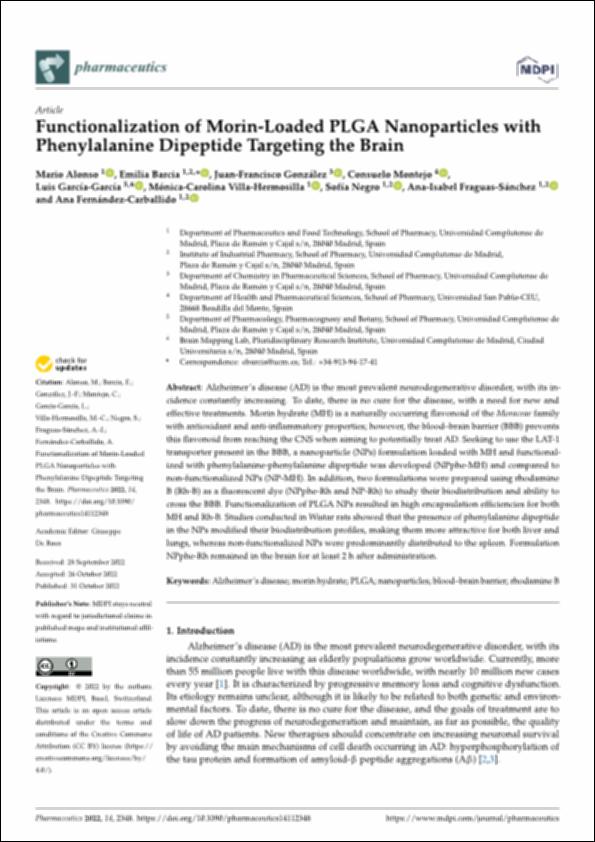Por favor, use este identificador para citar o enlazar este ítem:
http://hdl.handle.net/10637/14775Functionalization of Morin-Loaded PLGA Nanoparticles with Phenylalanine Dipeptide Targeting the Brain
| Título : | Functionalization of Morin-Loaded PLGA Nanoparticles with Phenylalanine Dipeptide Targeting the Brain |
| Autor : | Alonso González, Mario Barcia, Emilia González, Juan Francisco Montejo Rubio, María Consuelo García García, Luis Villa Hermosilla, Mónica Carolina Negro, Sofía Fraguas Sánchez, Ana Isabel Fernández Carballido, Ana |
| Materias: | Alzheimer’s disease; Morin hydrate; PLGA; Nanoparticles; Blood–brain barrier; Rhodamine B |
| Editorial : | MDPI |
| Citación : | Alonso, M.; Barcia, E.; González, J.-F.; Montejo, C.; García-García, L.; Villa-Hermosilla, M.-C.; Negro, S.; Fraguas-Sánchez, A.-I.; Fernández-Carballido, A. Functionalization of Morin-Loaded PLGA Nanoparticles with Phenylalanine Dipeptide Targeting the Brain. Pharmaceutics 2022, 14, 2348. https://doi.org/10.3390/ pharmaceutics14112348 |
| Resumen : | Alzheimer’s disease (AD) is the most prevalent neurodegenerative disorder, with its incidence constantly increasing. To date, there is no cure for the disease, with a need for new and effective treatments. Morin hydrate (MH) is a naturally occurring flavonoid of the Moraceae family with antioxidant and anti-inflammatory properties; however, the blood–brain barrier (BBB) prevents this flavonoid from reaching the CNS when aiming to potentially treat AD. Seeking to use the LAT-1 transporter present in the BBB, a nanoparticle (NPs) formulation loaded with MH and functionalized with phenylalanine-phenylalanine dipeptide was developed (NPphe-MH) and compared to non-functionalized NPs (NP-MH). In addition, two formulations were prepared using rhodamine B (Rh-B) as a fluorescent dye (NPphe-Rh and NP-Rh) to study their biodistribution and ability to cross the BBB. Functionalization of PLGA NPs resulted in high encapsulation efficiencies for both MH and Rh-B. Studies conducted in Wistar rats showed that the presence of phenylalanine dipeptide in the NPs modified their biodistribution profiles, making them more attractive for both liver and lungs, whereas non-functionalized NPs were predominantly distributed to the spleen. Formulation NPphe-Rh remained in the brain for at least 2 h after administration. |
| URI : | http://hdl.handle.net/10637/14775 |
| Derechos: | http://creativecommons.org/licenses/by/4.0/deed.es OpenAccess |
| ISSN : | 1999-4923 |
| Fecha de publicación : | 31-oct-2022 |
| Centro : | Universidad San Pablo-CEU |
| Aparece en las colecciones: | Facultad de Farmacia |
Los ítems de DSpace están protegidos por copyright, con todos los derechos reservados, a menos que se indique lo contrario.


